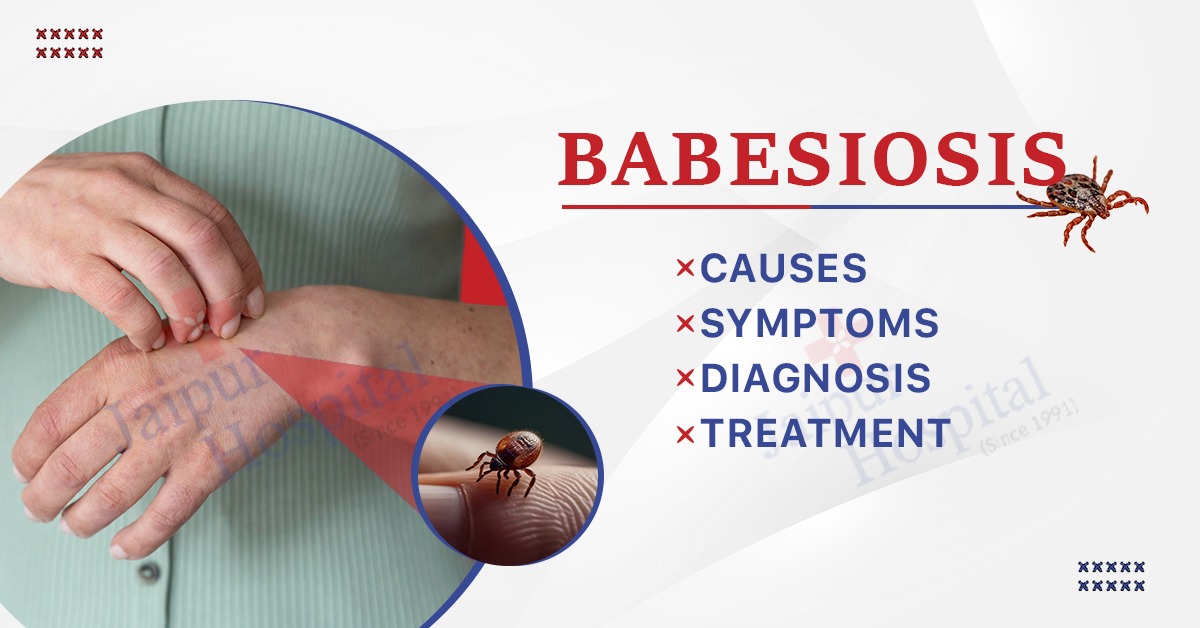What is Babesiosis?
Babesiosis is an infectious disease caused by microscopic parasites called Babesia. These parasites invade and multiply within red blood cells, leading to a range of symptoms in infected individuals. Babesiosis is typically transmitted through the bite of infected ticks, which serve as vectors for the disease. Symptoms can vary in severity and may include fever, chills, fatigue, sweats, headache, muscle aches, and, in some cases, anemia. While some individuals may not show any symptoms, others may develop severe illness, especially those with weakened immune systems. Babesiosis can be diagnosed through laboratory tests, including blood smears and PCR (polymerase chain reaction).
Symptoms of Babesiosis
The symptoms of babesiosis can vary from mild to severe, and in some cases, individuals infected with the Babesia parasites may not display any symptoms at all. When symptoms do occur, they typically appear one to four weeks after a tick bite. Common symptoms of babesiosis include:
- Fever: This is often one of the earliest and most common symptoms. The fever may be intermittent or continuous.
- Chills: Severe chills and shaking can accompany the fever, resembling the “rigors” seen in malaria.
- Fatigue: Feeling excessively tired or weak is common.
- Sweating: Profuse sweating, particularly at night, is a frequent symptom.
- Headache: Individuals with babesiosis often experience severe headaches.
- Muscle and Joint Pain: Aches and pains in the muscles and joints can occur.
- Nausea: Some people may feel nauseous or experience a general sense of discomfort.
- Loss of Appetite: There may be a decreased desire to eat.
- Enlarged Spleen: In some cases, the spleen may become enlarged, which can be detected by a healthcare provider during a physical examination.
- Dark Urine: In severe cases, urine may appear dark or discolored due to the breakdown of red blood cells
Also read: Psoriasis: Symptoms, Causes, Types, Risk Factors, Diagnosis & Treatment
Complications of Babesiosis
Babesiosis can lead to various complications, especially in severe cases or in individuals with weakened immune systems. Some of the potential complications associated with babesiosis include:
- Hemolytic Anemia: Babesia parasites invade and destroy red blood cells, a process known as hemolysis. This can lead to a significant reduction in red blood cell count, causing anemia. Anemia can result in fatigue, weakness, pallor, and, in severe cases, shortness of breath and heart palpitations.
- Organ Dysfunction: Severe cases of babesiosis can affect multiple organs, including the liver, kidneys, and lungs. Organ dysfunction can lead to various complications, such as jaundice (yellowing of the skin and eyes), kidney failure, and respiratory distress.
- Disseminated Intravascular Coagulation (DIC): In rare and severe cases, babesiosis can trigger a condition called DIC, where blood clotting and bleeding occur simultaneously. DIC is a life-threatening condition that can lead to internal bleeding and multi-organ failure.
- Splenectomy Complications: In individuals who have had their spleen removed (splenectomy), babesiosis can be more severe because the spleen plays a role in clearing infected red blood cells from the bloodstream. These individuals may require more intensive treatment and monitoring.
- Death: While babesiosis is generally a treatable disease, in very rare cases, particularly in individuals with underlying health conditions or compromised immune systems, it can be fatal. Prompt diagnosis and treatment are essential in reducing the risk of fatal outcomes.
Causes of Babesiosis
Babesiosis is caused by protozoan parasites of the genus Babesia. These parasites belong to the Phylum Apicomplexa and are related to the parasites that cause malaria. The primary cause of human babesiosis is infection with various species of the Babesia parasite.
Here’s how babesiosis is caused:
- Tick-Borne Transmission: The most common mode of transmission of Babesia parasites to humans is through the bite of infected ticks. Ticks are arachnids that feed on the blood of mammals, including humans. When an infected tick bites a person, it can transmit the Babesia parasites into the person’s bloodstream.
- Reservoir Hosts: Babesia parasites have reservoir hosts, which are usually wild animals such as deer, mice, and voles. Ticks become infected when they feed on these reservoir hosts, and they can then transmit the parasites to humans during a subsequent blood meal.
- Vertical Transmission: In rare cases, babesiosis can also be transmitted from mother to child during pregnancy or through blood transfusions or organ transplants from infected donors. Screening blood and organ donors for babesiosis has become more common to reduce the risk of transmission through transfusions or transplants.
Also read: Cellulitis: Types, Causes, Symptoms, and Treatments
Diagnosis of Babesiosis
The diagnosis of babesiosis typically involves a combination of clinical evaluation and laboratory tests. Since the symptoms of babesiosis can overlap with those of other illnesses, proper diagnosis is important to ensure appropriate treatment. Here are the key steps and methods involved in diagnosing babesiosis:
- Clinical Evaluation: A healthcare provider will start by conducting a thorough medical history and physical examination. They will inquire about symptoms, potential exposure to ticks, recent travel to areas with known tick-borne diseases, and any underlying health conditions.
- Blood Smear Examination: One of the primary diagnostic tests for babesiosis is the examination of a thin blood smear under a microscope. In this test, a small sample of the patient’s blood is spread on a glass slide, stained, and then examined for the presence of Babesia parasites within red blood cells. The parasites typically appear as small, ring-shaped structures called “trophozoites.”
- Polymerase Chain Reaction (PCR): PCR is a molecular diagnostic test that detects the genetic material (DNA) of the Babesia parasite. It can be more sensitive than blood smear examination, especially in cases where the parasite load in the blood is low. PCR testing can also help identify the specific species of Babesia responsible for the infection.
- Serologic Tests: Blood tests may be conducted to detect antibodies produced by the immune system in response to Babesia infection. Serologic tests can be useful for confirming a past infection but may not provide immediate diagnosis, as it can take time for the body to produce detectable antibodies.
- Other Laboratory Tests: Additional blood tests, such as a complete blood count (CBC) and liver function tests, may be performed to assess the impact of the infection on red blood cells and organ function.
- Differential Diagnosis: Since babesiosis symptoms can mimic those of other diseases, such as malaria or Lyme disease, it’s important for healthcare providers to consider a differential diagnosis and rule out other potential causes of the symptoms.
- Travel History: If the patient has recently traveled to regions where babesiosis is more common, this information can also help in making a diagnosis.
Risk Factors of Babesiosis
Several factors can increase an individual’s risk of contracting babesiosis. While the disease can affect people of all ages and backgrounds, certain factors may make some individuals more susceptible to babesiosis. These risk factors include:
- Geographic Location: Living in or visiting areas where babesiosis is prevalent, such as certain regions of the United States (e.g., Northeastern and Midwestern states), increases the risk of exposure to infected ticks.
- Outdoor Activities: Engaging in outdoor activities, such as hiking, camping, hunting, or gardening, in tick-infested areas raises the risk of tick bites and, consequently, the risk of babesiosis.
- Tick Exposure: Direct exposure to ticks, especially in areas with a high prevalence of infected ticks, increases the likelihood of acquiring babesiosis. Ticks are more active during warmer months.
- Tick Species: Certain species of ticks, such as Ixodes scapularis (deer ticks) and Ixodes pacificus (western black-legged ticks) in the United States, are more commonly associated with transmitting Babesia parasites. Being in areas where these tick species are prevalent raises the risk.
- Lack of Tick Bite Prevention Measures: Failing to take preventive measures to avoid tick bites, such as wearing protective clothing, using tick repellents, and conducting regular tick checks after outdoor activities, increases the risk of tick exposure.
- Weakened Immune System: Individuals with weakened immune systems, such as those with HIV/AIDS, cancer, or organ transplant recipients, are at greater risk of developing severe babesiosis if they become infected.
- Age: While babesiosis can affect individuals of all ages, the elderly and very young children may be more vulnerable to severe forms of the disease.
- Splenectomy: People who have had their spleens removed (splenectomy) or have a non-functioning spleen due to a medical condition are at higher risk of severe babesiosis, as the spleen plays a role in clearing infected red blood cells from the bloodstream.
- Blood Transfusions or Organ Transplants: Receiving blood transfusions or organs from donors who are unknowingly infected with Babesia parasites can transmit the disease to the recipient.
- Pregnancy: Pregnant individuals may be at a slightly higher risk of severe babesiosis due to changes in their immune system during pregnancy. However, severe cases during pregnancy are still relatively rare.
It’s important for individuals living in or visiting areas with known tick-borne diseases to be aware of these risk factors and take appropriate precautions to reduce their risk of tick bites. Preventive measures, such as using insect repellent, wearing protective clothing, and performing thorough tick checks, can help minimize the risk of contracting babesiosis and other tick-borne illnesses. Additionally, early diagnosis and treatment are essential for managing the disease effectively, especially in high-risk individuals.
Treatment of Babesiosis
The treatment of babesiosis typically involves the use of antiparasitic medications to target the Babesia parasites responsible for the infection. The choice of treatment and its duration may vary based on the severity of the infection, the specific species of Babesia involved, and individual factors, such as the patient’s age and overall health. Here are the commonly used medications for treating babesiosis:
- Atovaquone and Azithromycin: This combination is often the preferred first-line treatment for mild to moderate cases of babesiosis. Atovaquone interferes with the parasite’s ability to reproduce within red blood cells, while azithromycin is an antibiotic that helps control the infection. This combination is typically well-tolerated and is used for a duration of 7 to 10 days.
- Clindamycin and Quinine: In more severe cases of babesiosis or when the Atovaquone and Azithromycin combination is not effective, healthcare providers may prescribe a combination of clindamycin and quinine. Clindamycin is an antibiotic that works against the parasite, and quinine helps kill the parasites within red blood cells. This combination is typically administered intravenously in a hospital setting for severe cases.
- Exchange Transfusion: In life-threatening cases of babesiosis, particularly when severe hemolysis (breakdown of red blood cells) is occurring, exchange transfusion may be necessary. This procedure involves removing and replacing a portion of the patient’s infected blood with healthy donor blood to rapidly reduce the parasite load.
- Supportive Care: In addition to antiparasitic treatment, supportive care may be necessary to manage symptoms and complications. This can include measures to address anemia, maintain hydration, and provide pain relief or fever-reducing medications.
It’s important to note that babesiosis treatment should be guided by a healthcare provider, and patients should follow their prescribed treatment regimen carefully. Some individuals with mild or asymptomatic cases of babesiosis may not require treatment, as the infection can resolve on its own in some cases.
Patients should also be monitored closely during and after treatment to ensure the infection is cleared and that there are no complications. In some cases, follow-up blood tests may be needed to confirm that the parasites have been successfully eliminated.


